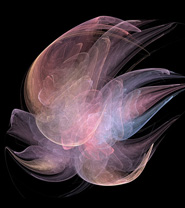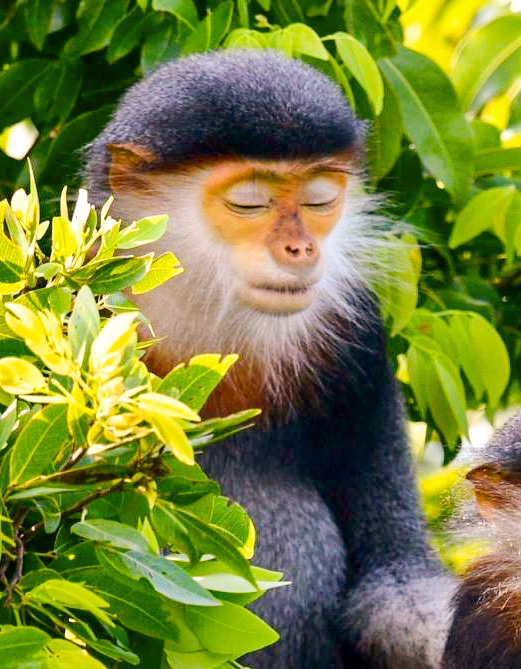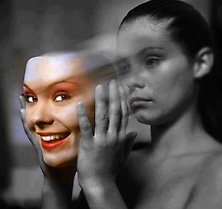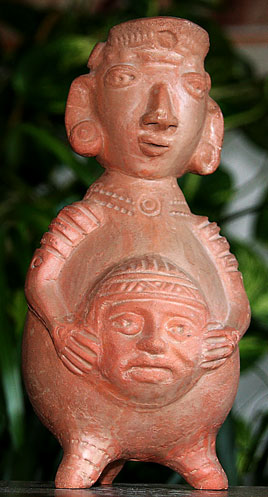|
THE INNER AND THE OUTER PERSON
"God has given you one face,
and you make yourself another."
— William Shakespeare
If you ask me, "Who are you?"
I would respond, "I am me."
Notice something interesting: You addressed 'me,' but it
was 'I' who answered. Before 'I' spoke, there was a pause—a
moment of reflection.
What did 'I' reflect on? Myself? Or perhaps... 'me'?
What can we infer from this brief, fictional dialogue? First and
foremost, we can deduce that we are composed of two entities: an
'I' and a 'me.' Secondly, the dialogue suggests
that 'I'
serves as the representative of 'me' in the external world.

Me and
I
In this exploration,
I will define
'me' as follows:
• An inner person, grounded in the body through
sensations and emotions. These instinctual sensory perceptions
are registered in awareness, as
described on
Meditation.dk. The body's interoceptive system functions as
an antenna, receiving and processing these signals. This is
'Me.' 'Me' experience itself through the ancient
evolutionary mechanisms embedded within us. It is the cumulative
sum of all biological beings that have, in some form, survived
and evolved within us since the pre-Cambrian sea. The biological
circuits comprising 'me' are varied and, due to their
different evolutionary ages, often operate out of sync. What
unifies them as 'me's' are their ancient lack lack of
language and self-reflection. 'Me' operates instinctively
because it predates the evolution of reflective cognition.
And 'I' as:
• An outer person, interacting with both the external
world and 'me' using language, reason, and feelings. In this
context, 'feelings' are defined according to modern psychology as
sensory signals and emotions interpreted and narrated by 'I.' Thus, 'I'
becomes a socially driven intro- and extrovert storyteller, weaving narratives for
the world and for myself about 'me.' This system unfolds in
consciousness (as defined on the site), and although slower
than 'me', it
has gained the advantage of language-based cognition.
Ocram's Razor Dualism
Broadly speaking, the distinction between 'I' and 'me' builds
upon the age-old dichotomy of emotion and reason, yet here we
see it connected to the vastly different operating systems of
consciousness and
awareness.
In reality, the interaction
between 'I' and 'me' is highly complex—consider
symbolic thinking, dream sequences, and visions, which bridge
both realms. However, this dualistic model offers us an
Ockham's
razor, providing a precise conceptual cut through this organic
complexity.
This distinction between 'I' (the outer, rational self) and 'me'
(the inner, emotional self) echoes
William James's ideas. As an
early psychologist, James differentiated between the "I" as 'the
self as knower' and the "Me" as 'the self as known.'
This mirrors how contemporary psychology views the self: both an
active agent (the "I") and an object of awareness
and consciousness (the "me").
Now a question arises: Am I me?
Out of mutible reasons it is not possible to give a satisfactory
answer to this question. Nevertheless 'I' will serve this question as a
subcurrent for you to ponder through the whole chapter. Here is
the first stream of the current:
'I' Live in an Apartment... 'Me' Lives in My Body... The Body
is 'Me's' Home.
'I' now repeat to myself the question you asked me at the
beginning:
Who am 'I'?
The simplest answer, again: I am me.
'I' am not 'I', but 'me'.
Or is that really true? 'I' might just pretend to be
'me'.
Another question is: Who or what is that 'me'? Is there a core
we could call 'me'? My core truth seems to be closer to
'me'
than to 'I', but does it give meaning to talk about an
essential 'me', a true self or an inner core? Before we
procede with the 'I' & 'me'-duality we need to
addres the following question:
Is there something we could call a true and essential
individuality?
IS THERE ANYTHING
AUTHENTIC IN 'ME'?
Who am I? Both
modern science and ancient Indian Buddhist philosophy suggest that the
concept of an "authentic self" may be an illusion. Yet, like
"redness," which cannot be measured or weighed but still holds
meaning in human consciousness, the idea of self, though
seemingly illusory, serves a profound purpose. The same can be said of free
will—abstract, perhaps, but integral to our experience of being.
Even when acknowledging the potential illusion of individuality
and identity, it remains meaningful to characterize
individuality as a dynamic
flow-state.
Our true nature, then, becomes the most deeply felt and
consciously realized balance point among the conflicting
impulses and inner voices that make up our psychological and
biological existence.
The Scientific
Drive to
Substatiate Existence
Lord Kelvin,
the influential 19th-century physicist and engineer, once said:
"When you can
measure what you are speaking about, and express it in numbers,
you know something about it; but when you cannot measure it,
when you cannot express it in numbers, your knowledge is of a
meagre and unsatisfactory kind."
Though scientific philosophy has
evolved significantly since the heyday of logical positivism,
this type of rigid empiricism remains embedded within the
framework of modern science. It lingers, much like a
subconscious trauma from childhood, influencing the way we
approach and understand the world. From here it penetrates
psychology and even social sciences
This mindset — which seeks to reduce all phenomena to measurable
quantities — can be limiting when applied to the question of
individuality or the self. How many grams does the soul weigh?
The laboratory's pursuit of tangible evidence for individuality,
while valuable in specific contexts, reflects a deep-seated bias
that favors solidity as the primary criterion for existence.
The hard problem of
consciousness—which asks how subjective experiences arise
from physical processes—mirrors the scientific struggle to
substantiate existence through empirical measurement. Just as
individuality defies reduction to quantifiable data,
consciousness resists being fully explained by neural activity
alone, pointing to the limitations of a strictly materialist
approach. This parallels the broader challenge of acknowledging
realities like the "self" that, while not directly measurable,
are undeniably integral to human experience.
In summary, the scientific approach has been invaluable in many
domains, but it falters when addressing subjective, experiential
phenomena.
In this light, the urge to define the "self" as a fixed,
unchangeable entity not only becomes unnecessary but ultimately
restrictive. Rather than searching for a soul that can be
captured, weighed, or quantified, it is more apt to
conceptualize individuality as a dynamic equilibrium within a
biological network. This network stretches back to the
primordial beginnings of life in the pre-Cambrian seas,
extending forward to the complex interweaving of emotions,
cognition, and consciousness that define modern human
experience.
The subjective but authentic experience of flow embodies this
dynamic equilibrium—a state where our diverse biological systems
harmonize and work together, much like a democratic society
where every voice, even the minority, is heard and respected as
part of the decision-making process.
The Deeper
the Flow, the Truer the Glow and the more Real I feel
Our sense of genuine
individuality is intimately tied to this experience of flow. The
deeper, more profound, and expansive the point of balance, the
more it resonates with the deepest, oldest, and most unconscious
layers of our cellular existence. The more we feel, see, and
listen into the dark evolutionary abyss inside of us, the more
the
Nietzschean “monsters” within us smile—and as they do, the
more meaningful and essential our sense of self becomes.
By "deep," I refer to consciousness' ability to bring awareness
to the most hidden, primal aspects of our biology. This is the
path of true introspection.
Paradoxically, this inward journey toward the true, fluctuating
self makes life’s external actions remarkably tangible: every
word and action matters. Each small movement in life either
brings us closer to or pulls us further from the deep
flow-feeling of purpose. In this sense, I am not a fixed thing
but a dynamic state—much like the experience of "redness" or the
subjective feeling of freedom.
In the end, perhaps the question is not whether I am
'solidifyable', but whether I am in touch with the dynamic flow
of me. The deeper I allow myself to venture into the shifting
currents of my being, the more vividly I can experience life as
a living process—ever-changing, always in motion. It is in
embracing this fluidity that I find my true authenticity, not as
something fixed or predetermined, but as an ever-evolving state
of becoming. The higher I flow, the deeper I glow.
A NEW 'I' AND AN OLD 'ME'
Having defined what constitutes true individual essence,
it's now essential to anchor this concept within the 'I' and
'me' duality. It is highly meaningful to view this deeply
personal balance as a dialectical dance between the two. 'You'
and 'us' are also key dancers in this broader play, but for now,
we'll focus on 'I' and 'me.'
In reality, the boundary between 'I' and 'me' is not as
clear-cut as it might seem. In essence, 'me' can be understood
as a collective term for older, instinctual biological systems,
while 'I' refers to the newer cognitive systems that have
evolved over time—from the primordial seas to the present.
Together, these form the composite of what we call the human
being, viewed through the lens of evolutionary bio-psychology.
Our outer 'I'-personality is, in more than one sense,
superficial. The brain can be compared to a tree in its
evolutionary development. The deeper we go into the brain, the
older its "rings" become. Deeply buried at its core, in the
brainstem, lies the 'me,' representing the evolutionarily older
and ancient layers of the brain. The outermost and newest part
is the cerebral cortex.
In the cerebral cortex, specifically in the neocortex and
primarily the frontal lobes, lies what defines us most as human.
This is the command center of our most recently evolved,
conscious awareness. From here, commanding neurons send messages
to the control centers in the primal brain. Our wild,
ancestral Fenrir wolf
or even deeper, the
Indian reptile
Kundalini snake, is, in brain mythology, bound by these neural
threads.
When we hide or control our instincts, we simultaneously conceal
our oldest biological layers. Our essence, our “me,” is hidden
in the depths. To be a deep person means to be in contact with
these oldest layers of the brain. Self-control leads to behavior
that, like a layer of civilizing lacquer, varnishes over the
inner animals.
The Inner Bodily Being
Deep within the dark spaces of the body, centered around the
abdomen, we carry a small, sensitive, childlike, instinctual
creature. It has direct sense-based instinctual contact with the
outside world way before we as 'I' have. Let me give a short
example: Someone in a social gathering craks a joke about you.
Everybody, including you, laugh. The next morning your 'I' comes
to realise that 'me' did not like the joke. In fact, me did not
understand the joke a all, but 'me' sensed the carrier wave of
micro-aggressive emotion in it.
This inner bodily being is 'me'. 'Me' is ancient and, in that sense,
more of a hybrid being than a person. This inner being thrives on and
exists within what on this site is defined as
awareness.
Meditation.dk consistently distinguishes between
'awareness' and
'consciousness'. Although all sensations and emotions are
products of brain activity, they are subjectively experienced in
the body's inner space. As mentioned, these sensations are
registered in awareness; they are noticed before being
consciously recognized by the 'I'.
Our connection to 'me' happens instinctively through attention. Attention, in its purest form, is wordless, while
consciousness is inextricably tied to language and reflection. A
split second later, 'I' translates this awarenes consciously and, therefore, also
in verbal form.

Total Recall 1990
'Me' as Biochemical Sensations
Now the challenge arises: Can we describe 'me' before 'I'
interprets it through language and culturally accepted norms?
For instance, what is the raw sensation of love before it was
ever named or categorized?
'I', 'Me', and Language
In this exploration, it is the conscious 'I', the outer
person, that interprets the 'me' through the tool of language.
Language, invented by 'I', serves as a means of external
communication, allowing us to plan and coordinate complex
survival strategies with others. As language evolved, so did our
capacity for internal thought, turning our thoughts into a form
of heard language, shaped by the sounds we use in speech.
As mentioned,
'me' stretches from a child’s undeveloped sense of identity back
to our evolutionary history, where 'me' is more like a wordless,
sensing creature. It resides in the bodily darkness, from the
pelvic floor to the throat, experienced as bundles of
biochemical sensations. When processed by 'I', these sensations
are translated into feelings such as joy, anger, fear, or love,
stored in 'I's linguistic archive. The task of 'I' is to name
and give form to these raw sensations.
However, 'me' exists in a state of wordless attention, abstract
bundles of sensations and emotions, unique to each individual.
The sensational aspect of 'me' is evolutionarily much older than
its emotional counterpart.
When 'me' is accessed through meditative awareness and
consciousness, we can trace
the process backward—from feeling to emotion to raw
sensation—before 'I'-consciousness interferes with its usual
interpretation. In this state, 'I' must invent new language,
often in the form of pictures and symbols, to approach
understanding this unknown territory. Dreams serve as an example
of this symbolic language.
Take, for example, a friend of mine who, during an LSD session,
experienced a meat-eating plant growing in his stomach. This
image represented the second brain in his gut, trying to
communicate that 'me' was displeased with how his 'I' was
treating him. One take away here is that the greater the dissonance between 'me' and 'I'
is,
the more profound the unhappiness and depression.
The unfoldment of an Iconic Language
AAnother key insight suggests the possibility of what could
be termed an iconic language, capable of reaching deeper into
the ancient "me" layers of our psyche. This is the realm of
symbolic thinking, explored through dreams, psychedelics, and
even in practices like astrology and tarot. These modes of
interaction communicate with our inner self, bypassing
conventional language and speaking directly to parts of our
being that are older and more primal.
For example, when people use tarot cards, they engage in a
symbolic dialogue with their subconscious. The archetypal
imagery in each card taps into collective human experiences and
emotions that transcend the boundaries of spoken language.
Whether or not one believes in the predictive power of tarot,
the process itself facilitates a deeper connection to intuition
and inner wisdom.
Astrology, too, operates on a symbolic plane, and in this
context, it matters little whether its claims are scientifically
"true." The signs, planets, and houses in astrology represent
various facets of the human experience and psyche, providing
individuals with a framework to explore themselves. The meaning
people derive from it is rooted in the symbolic connections they
make, much like interpreting a dream where a snake might
symbolize transformation or danger, depending on one's personal
or cultural associations.
Historically, symbolic thinking permeated ancient and medieval
worldviews. In ancient cultures, the flight of birds or the
movement of the stars was imbued with meaning, seen as direct
communication from the gods. Medieval society viewed comets as
omens of impending change, while sacred texts, religious
rituals, and alchemical symbols were understood not just as
literal facts but as guides to deeper spiritual truths. The
symbolic language of these eras connected people to the
mysteries of life in a way that rational discourse could not.
Dreams, too, remain one of the most profound forms of symbolic
thinking, offering insights through imagery rather than logic.
The work of Carl Jung highlights this, as he believed that dream
symbols arise from the collective unconscious, containing
universal archetypes—figures like the hero, the shadow, or the
mother—that speak to our deepest psychological and emotional
states.
In all of these examples, symbolic thinking has the power to
evoke a felt sense of meaning and purpose that conventional
language often struggles to articulate. Whether through the
images of tarot cards, the astrological map of the stars, or the
potent symbols in our dreams, this iconic language reaches parts
of ourselves that are otherwise inaccessible, bridging the gap
between the rational 'I' and the instinctual 'me.'
A new Symbolic Language in which 'I' can Understand 'me'
Let us now explore the potential for creating a new symbolic
language as an extension of the 'I's' vocabulary of feelings and
sensations. I will illustrate this shift from conventional
language to the realm of imagination and symbolism:
There are countless ancient parts of 'me' that are felt but
remain wordless. In line with the earlier example of LSD-induced
imagery, let’s consider how a particular sensed
configuration—perhaps an almost electric, tingling sensation in
the torso—could be symbolized as an inner jellyfish or,
depending on the perceived intensity of threat, a Portuguese
man-of-war. The jellyfish, with its soft and flowing body, might
represent a state of vulnerability, its center pulsating in the
primordial sea of the abdomen, connected to our oldest emotional
and physical instincts. However, when 'me' feels threatened or
angry, this vulnerable creature transforms into a more defensive
figure—a man-of-war, with its tentacles charged and ready for
combat.
This metaphor illustrates how symbolic thinking enables us to
externalize and give form to sensations that are otherwise
elusive, providing 'I' with a richer, more nuanced vocabulary to
describe the inner workings of 'me.' Through this symbolic
imagery, we bridge the gap between raw sensation and conscious
understanding, allowing us to navigate and articulate the
complexities of our emotional landscapes.
This experiment in symbolic language expands 'I's' ability to
engage with 'me' on its own terms, recognizing the dynamic,
often subconscious layers of experience that conventional
language cannot fully capture.

C.G.Jung and the Jungian
school after him have in the exploration of archetypes and
myths made familiar theories. However, there is a great
difference
THE SURVIVAL OF 'ME'
Within us lie ancient survival systems, inherited from our
evolutionary past. These instinctive circuits continuously
evaluate external inputs with one core question: Is there a
threat? Will I survive?
The inner person operates its own survival systems, with the
greatest strength being their instinctual speed. However, what
it gains in speed, it sacrifices in creativity. These older
systems, suited for simpler environments, struggle to cope with
the complexities of modern life, which require more nuanced
responses.
This is where the outer person comes into play. The inner person
is protected and regulated by a reflective, slower outer person,
bridging the gap between instinct and the demands of
contemporary life.
The Guard
The primary role of the outer
person is to safeguard the inner 'me'. The 'I’s task is to
ensure the survival of the inner being by using a broader
repertoire of thoughtful, verbalized strategies.
The outer person acts like a knight in armor, guiding the inner
"primitive" creature through life’s dangers. The sensations of
the inner me inform whether to attack, flee, or wait. The knight
also considers whether these reactions are appropriate.
The outer person wields reason as its most powerful tool. This
ability to control impulses, analyze situations, and communicate
improves me’s survival chances. While me’s instincts are quick,
they often fall short in navigating the complexities of modern
life.
The Outer Person's Dual Role
The outer person plays a dual role, much like an actor. On
one hand, it performs the life that the modern control society
has programmed into us, while on the other hand, it acts as a
parent, protecting and guiding the inner person. The mask serves
both as a tool for survival in relation to the world and as a
protective helmet.
This psychological split is the price we have paid since ancient
times to enjoy the benefits of being a member of society.
Who Came First: Me or I?
'Me' came first. As children, we express "me" long before we
learn to say "I." This mirrors our evolution: the emotional
brain developed before the rational neocortex. Similarly,
attention precedes consciousness—animals are attentive but not
self-aware in the human sense.
In times of acute stress, it is the outer person that falters
first. Higher functions like planning deteriorate under stress,
exposing the primal inner me. Evolution has prioritized me’s
reactive instincts over I’s reflection. In breakdowns, 'I'
collapses, and me persists. 'Me' can survive without 'I', but
not the reverse.
'I' and 'Me' in Constant Conflict
"Nobody, as long as he moves about the chaotic
currents of life, is without trouble."
C.G. Jung
The inner person is full of varied
ancient sensations and emotions, which often push 'I' into rigid
conclusions based on survival instincts.
The outer person, in contrast, has the gift of reflection,
allowing reconsideration after the fact. This ability to
strategize and apologize tempers the inner person’s more
primitive systems. The outer 'I' constantly evaluates and
controls the inner person’s impulses.
Being human is a balance between bio-operating systems. The
outer person reflects, strategizes, and gives us the capacity to
plan, but this comes at the cost of time. Instinctual responses
from the inner system are faster and often more critical in
immediate survival scenarios.
Both systems are necessary, and neither can function in
isolation.
Who Holds the Power?
At first glance, the outer person seems in control,
suppressing the instinctual reactions of the inner person.
Social norms help us override our emotions. However, this
control is superficial. In reality, the emotional, instinctual
me holds fundamental power. The outer rational brain exists to
serve the survival of the primal systems.
I Know 'Me', But 'Me' Does Not Know 'I'
Of What is significant in one's own existence one is hardly
aware,
and it certainly should not bother the other fellow. What does a
fish know about the water in which he swims all his life?
Albert Einstein
In its simplest form, 'me' is like
an attentive animal, reacting instinctively but unaware of
identity. 'I', however, is self-aware and can verbalize me’s
emotions. 'I' tells the story of 'me', interpreting its
reactions.
Despite this, 'me' remains unaware of 'I'. The inner me doesn’t
need words or reason; it simply reacts. Without language, 'I'
wouldn’t exist in its current form.
In practice, 'I' often interprets me’s reactions, creating
narratives to explain emotions. However, the body, closely
aligned with 'me', responds to physical sensations—touch,
warmth—better than words ever could.
'I' lives in the realm of language and reason, constantly aware
of itself and 'me'. Yet much of 'me' remains in a state of
wordless sensation. As Einstein noted: "What does a fish know
about the water in which he swims all his life?"
THE INFLUENCE OF SOCIETY AND THE ROLE OF THE MASK
There's a bluebird in my heart that want to get out,
but I am too tough for him. I say, stay in there,
I'm not going to let anybody see you.
Charles Bukowski
Society interfaces with our bio-operating systems. The outer
'I' is crucial for navigating social life, shaped to perform
self-control and interaction. The "mask" we wear manages how we
present ourselves to protect the fragile inner me.
The Civilized Masquerade
Every advanced civilization creates and depends on a
masquerade. Since ancient times, we have worn the outer mask of
self-control. In the theaters of ancient Greece, actors
performed with masks. These masks were called "personas," a word
from which we derive the term "person."
The Ironic 'I'
The outer person manages social interactions, often through
projecting a polished version of ourselves. Irony and humor are
key tools in this social navigation, demonstrating mastery of
these interactions.
Outer persons not only control themselves but also engage in
complex social "games" aimed at managing each other’s inner
persons. The late-modern outer human has donned a verbal armor
of irony for this purpose.
The Outer Person's Irony Hinders Spontaneous Spiritual Growth
"Then turn to great and serious objects that make you feel
small and helpless.
Search out the deeper level of things to which irony never
descends."
— Rainer Maria Rilke, Letters to a Young Poet
The outer person becomes especially active in groups, taking on
a performative role. In such settings, we protect ourselves by
playing ourselves rather than being ourselves. Often, this
protection manifests through irony, used to conceal the
vulnerability of inner presence.
In social gatherings, ironic behavior frequently serves to wage
subtle, hierarchical power struggles, masked by polite, almost
invisible insults. This small, daily demonstration of personal
dominance forms the first defense in verbal duels, fought in the
borderlands between seriousness and humor. This type of irony is
cynical, reflected in its narrative that it's all "just
friendly."
The fast-paced, humorous, and ironic exchanges are common in
workplaces or casual social settings, like when friends gather
for a drink. Here, individuals duel with seemingly harmless
wordplay, as the group or its leader instinctively picks a
target. The target is expected to show strength by laughing
along, maintaining self-control. It's all just fun and games,
after all. Yet, these interactions always have winners and
losers. The "loser" is tasked with shielding their inner self
behind a persona, hiding any small emotional wound. Their only
recourse is to return a clever, cutting remark that catches the
original "winner" off guard.
In this group dynamic, the collective laughter over the target's
perceived foolishness offers temporary relief from each member's
own inner turmoil. As the laughter fades, so does this fleeting
sense of camaraderie. Meanwhile, the one who initiated the jabs
feels a momentary sense of control, an ephemeral pleasure in
being on top.
This borrowed sense of power compensates for a lack of inner
flow. In the long run, the victor in this cynical, ironic social
interaction is always the outer person. The loser is the inner
self.
It may seem as if I’m indulging in an overly sentimental defense
of the fragile inner child. In most other contexts, this
critique might seem trivial, but not when the goal is to
cultivate a strong, meditative group dynamic. The ironic mode of
interaction is simply incompatible with the meditative process.
Irony and Meta-Awareness
Irony, in itself, isn’t necessarily a negative thing. It can
be a tool for fostering meta-awareness. A good friend, with a
well-timed, ironic remark, can make you see yourself from an
outside perspective.
Thus, the issue is not irony itself but the intention behind it.
This form of irony that cultivates meta-awareness works best in
one-on-one interactions. In larger group dynamics, there is
often a lowest common denominator, and it's rare that irony will
be used with the right motivations in such settings.
In modern society, individuals must control their inner selves.
The outer person has developed an elaborate "armor" to keep
vulnerabilities hidden. This mask is not just for survival but
also a performance aligning with societal expectations.
Cultures create pressures that shape the outer person. The outer
self becomes adept at managing the inner me, often suppressing
emotions deep into the subconscious. Today, the mask is not just
external but part of how we think and feel.
However, the more we develop the outer 'I' for society, the more
distant we become from the inner me. This can lead to feelings
of inauthenticity or burnout, especially in high-stress
environments.
When the Outer Person Takes
Over
There is often a complementary relationship between the
inner and outer person, where many people today invest nearly
all their energy in developing a compensatory outer persona. The
primary function of the outer person in this context is to
conceal the vulnerability of the inner self.
Leaders, highly ambitious individuals, and perfectionists
frequently invest most of their energy in the outer person,
intending to compensate for the inner self’s unruly sense of
lostness—a feeling that only deepens as the outer person gains
more control. The more dominance the outer persona exerts over
the inner, the less capable one becomes of feeling connected to
oneself, of sensing the untamed, chaotic life within the body’s
dark interior.
Stress and the Erosion of the Outer Person
The more society emphasizes control and productivity, the
more fragile the outer person becomes under stress. Chronic
stress strips away the outer 'I', revealing the primal me
beneath. As higher functions deteriorate, the emotional,
instinctual me takes over.
In this process, the polished self cracks, and society’s masks
begin to fail. We are left with raw emotions and primal
instincts. The more the outer person is forced to control, the
more fragile it becomes. In the end, the inner me proves more
resilient in facing life’s challenges.
MEDITATION AS A BRIDGE BETWEEN ME' AND 'I'
"The privilege
of a lifetime is to become who you truly are."
C.G.Jung
In meditation, we focus not on controlling thoughts or emotions
but on being present with them—just as they are, in their purest
form. The paradox is that while only 'I' can be aware of me, true
insight arises from simply observing, rather than trying to
understand or control. As Meister Eckhart said, "In unknowing
knowing shall we know God." Through stillness and attention, we
allow 'me' to surface, unfiltered by language or cognition.
Meditation, then, is primarily directed toward 'me'. It seeks to
bring attention to the body’s inner depths, where the primal,
instinctual 'me' resides. In this space, 'me' is free to express
itself, to sense, to be. The outer I simply watches, cultivating
awareness without interference. And in this process, 'me' can
finally be seen and felt.
The irony is that I is the only part of us that can be aware of
this process. I cannot "create" meditation, but it can
facilitate the conditions in which meditation naturally arises.
In the same way that grass grows without effort, meditation
happens when we stop trying to control it. It is in letting
go—of effort, of understanding, of the need for outcomes—that
the deep, wordless flow of me comes alive.
The Foolish Inner Self
The emotional well-being and potential growth of the inner
person are crucial to our overall quality of life. However, the
inner person itself is far from ideal. It is often childish,
animalistic, selfish, and biased. For this reason, the slower,
more reflective "I" has often locked away this unruly side of
ourselves, sometimes so deeply that we aren't even aware of its
existence. Releasing the inner person into the world requires
courage, as doing so may unravel the life we know.
The issue is that imprisonment does not rehabilitate; instead,
it breeds more disorder. Suppressive and disciplinary thoughts,
no matter how wise, struggle to change the inner, animalistic
"me" because the inner self does not understand words. It
responds to touch but not language. Therefore, the wise and
rational part of us delivers sermons to deaf ears.
ONLY THE INNER
PERSON CAN MEDITATE
Meditation in Vulnerable Strength
"Rip
off your mask!
Your face is glorious."
—Rumi
•
"Appear as you are,
be as you appear."
—Rumi
•
"A human has many layers of skin covering the depths of its
heart.
Humanity knows many things; it does not know itself.
Yes, thirty or forty skins or hides, like those of an ox or a
bear,
thick and tough, cover the soul.
Go into your own ground and learn to know yourself there."
—Meister Eckhart
I often
hear from people who have started meditating that their practice
no longer really works—they find themselves bored or distracted
by thoughts. They ask for more instruction and techniques.
It is our 'I' that demands techniques and fixed meditative
routines. The 'I' is a vital part of our ego's ability to plan
mental strategies that allow us to act rationally. This survival
and protective system is useful for putting bread on the table
but functions poorly as an engine for meditation.
That’s why I repeat my life experience like a mantra on
meditation.dk:
'I' cannot meditate... but 'I' can allow myself to be meditated."
Meditation is a spontaneous and uncontrollable process where the
'I'
surrenders by mindfully doing nothing.
In surrender, there is no space for understanding or will-based
action.
The more 'I' tries to understand and control meditation, the
"drier" and less inspired it becomes.
You cannot create a meditative flow through understanding and
will.
You cannot "bodybuild" consciousness.
However, what stands in the way of meditation is deeply affected
by understanding and will.
My intellect’s task is to realize that it fundamentally cannot
understand meditation, and therefore, cannot create or control
the process.
Next, my task is to understand what hinders meditation rather
than figuring out how to meditate. For instance, 'I' can analyze
and identify the life situations where meditation does not occur
naturally.
For anyone drawn to a life of meditation, it’s always important
to ask: Am I in the right work situation? Am I surrounded by
people who are in flow themselves? This kind of analytical
self-awareness is often a necessary broom, a life GPS, enabling
us to identify all the situations where we are likely not in
flow and far from the inner river that can carry us to the sea.
Now the question is: If I cannot figure out how to meditate,
then who is the one meditating?
Where
Buddha pointed to the moon, it is now time to point to the moon
as it is reflected in the emotional sea within the inner body.
In this context, meditation refers to the process in which pure
awareness spontaneously scans the inner body, gradually
dissolving emotional wounds and blockages. Feel to heal.
Wellness here is a byproduct, not the ultimate goal of life in
meditation.
Meditation
as a Bio-Feedback Process
Self-referential feedback arises only in sensitivity. As
mentioned on Meditation.dk, a crucial yet overlooked aspect of
the meditative phenomenon is the self-referential feedback that
emerges when sensitive awareness turns inward, much like a
microphone coming too close to a speaker.
The foundation for effortless meditation is created through this
introverted bio-feedback, which only the sensitivity of the
sensory "microphone" can generate.
This is where our new nervous system has its greatest strength:
sensitivity itself is the key. It’s a new key, designed to open
a door we haven’t yet seen.
The keys of the past cannot open the doors of the future.
Meditation is a form of neurofeedback, where heightened
awareness leads to an automatic, self-reinforcing bio-feedback
loop as described in the chapter,
The Ouroboros
Consciousness. In this context I will concentrate on this
feed back as a process happening between the inner and outer
self.
The duality
of self is here tied to both biological evolution, 'me' and 'I',
and social constructs.

The Meditating Animal
"Me," the inner person, is partly a little animal residing in
the sensed space of the body. Only when 'I' am fully in contact
with this "me," and willingly let it take control, does
meditation happen spontaneously. In this sense, both sex and meditation are
rooted in animalistic desire. The inner person can only be in meditation
when the flow to do so is driven by pleasure. Immediate
gratification—pleasure and play in a broader sense—provides the
best motivation for the inner "me." However, pleasure requires
me to let go of control. Just as someone using technique during
sex moves away from their natural instinct, no one can
"technique" their way to meditative bliss.
The reason I have remained in meditation year after year is that
it feels good for the little monkey inside me—not because I
planned it as a way to become a better person.
Meditation is both as easy and as difficult as love. Just as we
can never master love, meditation eludes those who chase it.
If meditation does not passionately meditate you, then you're
simply wasting your time by trying. It's better to wait for the
inspiration, much like a surfer waiting for the right wave.
When the right wave comes, and you are awake and aware enough to
see and feel it approaching, you can joyfully ride it in a flow
of awareness—a wordless sensation flowing through the inner
body. If you want anything other than what this moment is giving
you, you will immediately be thrown off the wave. It is this
flowing feeling that gives life its meaning, because in the
instant it arises, all questions disappear.
The meaning of life is not found in a golden pot at the end of a
rainbow of thoughts. The inner meditative flow is much closer to
an artistic act, where the artist is the artwork. We are
meditated like a dancer in free movement. This flow-dancer lives
in and through mindful silence. He never repeats himself but
cultivates life’s ever-fresh answers in all their unpredictable
and unruly forms.
The Inner Person within the
Outer Person

Ripples in the water from 'me' to 'I' to 'you'.
"When I saw you I fell in love,
and you smiled because you knew"
—William Shakespeare
"Never wear a mask... To be authentic means to be true to
oneself. It is a very, very dangerous phenomenon; only rare
people can do that. But whenever people do it, they achieve.
They achieve such beauty, such grace, such contentment that you
cannot imagine. Be true to yourself ... to be oneself ... moment
to moment... Never wear a mask."
—Osho
What awaits the inner person as
the prison doors open?
This feedback loop requires a sensitivity that reaches out to
the very edges of our nerves, where sensitivity turns into
vulnerability. Without this, your "microphone of awareness"
cannot go into meditative self-resonance.
Spontaneous self-resonance in meditative flow existentially
requires you to be as honest as possible with yourself. Even the
smallest inner lies prevent you from sensing yourself enough to
allow the feedback between your "I" and "me" to reach that point
of no return, where you are meditated rather than meditating.
Stress does exactly the same thing.
The purpose of self-deception is to protect you from pain, but
without confronting that pain, you cannot enter into inner
resonance. Meditation is not about cultivating pain, nor is it
about chasing positive thinking. It’s about simply, wordlessly
revealing and being in what is.
This is one of the central realizations here on Meditation.dk:
Only those who dare to be honest with themselves in utmost
sensitivity can be
meditated. This honesty is happening in the space between 'me'
and 'I'.
The greatest gift we can give another person is pure, wakeful,
thought-free attention. Now, offer that same gift of attention
to yourself. Why does the inner person understand attention?
Because it can feel attention. The inner person feels.
Its self-referential system consists of attention. The sense of
touch is our most significant and crucial organ, not only
responsible for sensing through the skin but more importantly,
for registering the incredible variety of nameless sensations
within the inner body.
Without this awareness, the inner person would be in poor
condition. In pure awareness, there’s nothing to understand—only
space for feelings, for the inner person is, above all, a bundle
of emotions.
In a life cultivated by meditation, you gradually bypass the
overheated thought-operating system. What replaces it? A new,
intuitive, hyper-awake, and almost non-cognitive system. In this
hyper-aware state, you can live happily with 90% fewer thoughts.
Here, we are not just aware; we are aware that we are aware.
We need two wings for our flight into the skies. One is a bodily
felt awareness. The other is hyper-awake, thought-free
consciousness.
The vision is to bring the inner person into the light of
consciousness and the warmth of wakeful, narrative-free
attention so that it can grow wise like a tree in a fairytale.
Slowly, this hyper-aware, inward-focused attention causes the
inner and outer persons to stop fighting and start merging into
a coherent being. This takes time... a long time... for Rome
wasn’t built in a day. This fusion is created by the
micro-actions of our lives. We are composed of micro-moments.
Every time you remember—not only during meditation but
throughout the day—turn your attention inward with an innocent
"aha." Every time we consciously sense ourselves in wordless
awareness, we create a small micro-change in the right
direction.
Thus, even a single second of thought-free inner awareness is a
victory.
The ideal here is to be able to say about oneself: "I rest in
myself. I am at home in myself."
I live in an apartment... Me lives in my body... The body is
me’s home.
Meditation creates a happy me who feels at home in the body.
The intimate sensed connection between "I" and "me" not only
constitutes our relationship with ourselves but also with the
world. When I rest in myself, this relationship ripples out to
our close relationships and surroundings. The more I love me,
the more I can embrace the entire world.
I recognize myself with sympathy in what I meet and see.
The inner person can only be meditated by stepping into the
daylight. This allows the soul to breathe out through the cracks
of the outer person.
Meditation is self-love.
Let us end with a quote from Sylvia Plath:
"I took a deep breath and
listened to the old brag of my heart:
I am, I am, I am."
With glow and flow -
Gunnar Mühlmann
|







